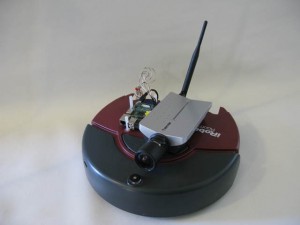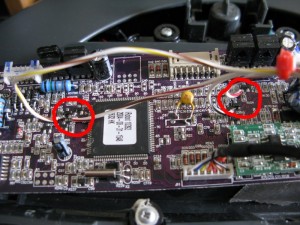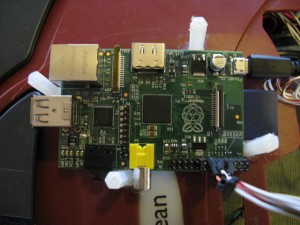Hi! My name’s Ben.
I’ve always had a big interest in robotics and electronics in general,
so when I heard about the Raspberry Pi, I knew I had to build a robot
around it. This is what I came up with:
The base of the robot is an old iRobot roomba 4000 with all of the cleaning brushes and their respective motors removed.
The model of roomba that I used has two drive wheels and a coaster wheel
in front, and the drive wheels draw almost 300mA of current, so
powering them directly off of the Raspberry Pi’s GPIO obviously wouldn’t
work. So, I considered using a relay board to control the two drive
motors from the GPIO. However, it turns that all the good boards were a
little too expensive for a hobby project, so I decided to open the
roomba up and see if I could somehow control the motors from the
existing circuitry. Guess what? It turns out that there are four small
transistors on the main board that power four larger transistors that
deliver power to the motors. This means that there are two transistors
per motor: one for forwards and one for backwards.
They’re labeled Q13, Q14, Q30 and an un-labeled one near R129.
I had a little help in discovering this from a video that a man named
Dean Segovis had posted on YouTube, but I ended up taking a multimeter
to the board; just to make sure that I wasn’t hooking my precious pi up
to anything dangerous. You can watch Dean’s video here: https://www.youtube.com/watch?v=TVp6QWcoilk.
Once I had confirmed the location of the transistors I needed on the
board, I connected their bases to GPIO pins 4, 17, 18 and 21 on the
Raspberry pi with with a 16 pin socket that I had lying around.
To power the Raspberry Pi, I soldered together a power supply circuit
around a 1 amp 5 volt regulator (basically the regulator and two
capacitors) on a piece of perf board and had the 5v output from the
regulator run to a micro USB connector. I also added some miscellaneous
components to the circuit, like a power switch, a 2.5 Amp fuse, a 12
volt in socket and some 12 volt out sockets; one of which the camera is
plugged into. The roomba’s main board is also plugged into a 12 volt out
socket.
For the camera, I just used an ip network camera from the company Vivotek.
I had tried to use a USB webcam that you might use for skype calls, but
streaming video from the pi slowed it way down and the picture quality
wasn’t as good as I had wanted. I wasn’t using the best webcam in the
world, though.
To hold the Pi in place on the robot, I just glued some plastic pegs where I wanted it to go:
One in between the USB and Ethernet ports, one in between the audio jack and the component video port, one near the HDMI port
and one near the SD card slot. This makes it easy to remove the Pi from
the robot when It isn’t in use, yet it holds it in place very well.
The entire robot is powered off of a small 12 volt lead acid battery
that fits nicely into the slot where the roomba’s original battery went.
I could have used the original battery, but the one that came with my
roomba was extremely old and wouldn’t take a charge any more. .
Lastly, I wrote some software in python to take input from a Nintendo
wii remote and transmit the input it got to the Pi over wifi, where
it’s decoded by another piece of python software and the wheels are
moved according to the position of the joysticks on the wii remote. You
can get my code at the links below:
Server.py – This one runs on the Raspberry Pi:
Server.py
Client.py – This one runs on your “base station” computer, a laptop for example:
Client.py
You can watch a short video of me driving the robot around on my YouTube channel:
https://www.youtube.com/user/doitnowlabs
And I think that’s about it. If I was unclear about anything or if
you want a more detailed description of my project, please email me at
benhjake (at) gmail.com , or leave a comment below. Also, if you
replicate my project, I’d love to see a picture or two. You could email
those to the same address. Thanks, and Happy Hacking!


